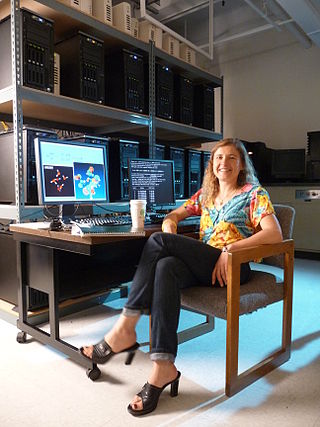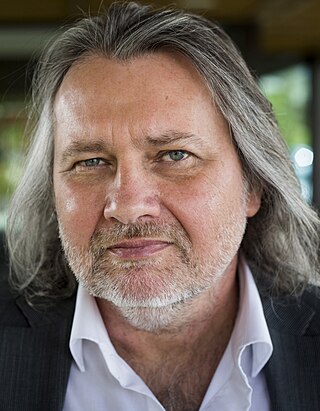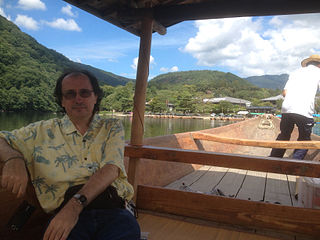Related Research Articles

Eric Allin Cornell is an American physicist who, along with Carl E. Wieman, was able to synthesize the first Bose–Einstein condensate in 1995. For their efforts, Cornell, Wieman, and Wolfgang Ketterle shared the Nobel Prize in Physics in 2001.

Deborah Shiu-lan Jin was an American physicist and fellow with the National Institute of Standards and Technology (NIST); Professor Adjunct, Department of Physics at the University of Colorado; and a fellow of the JILA, a NIST joint laboratory with the University of Colorado.

Richard Neil Zare is the Marguerite Blake Wilbur Professor in Natural Science and a Professor of Chemistry at Stanford University. Throughout his career, Zare has made a considerable impact in physical chemistry and analytical chemistry, particularly through the development of laser-induced fluorescence (LIF) and the study of chemical reactions at the molecular and nanoscale level. LIF is an extremely sensitive technique with applications ranging from analytical chemistry and molecular biology to astrophysics. One of its applications was the sequencing of the human genome.

William Esco Moerner, also known as W. E. Moerner, is an American physical chemist and chemical physicist with current work in the biophysics and imaging of single molecules. He is credited with achieving the first optical detection and spectroscopy of a single molecule in condensed phases, along with his postdoc, Lothar Kador. Optical study of single molecules has subsequently become a widely used single-molecule experiment in chemistry, physics and biology. In 2014, he was awarded the Nobel Prize in Chemistry.
Sylvia Teresse Ceyer is a professor of chemistry at MIT, holding the John C. Sheehan Chair in Chemistry. Until 2006, she held the chemistry chair of the National Academy of Sciences.
This page deals with the electron affinity as a property of isolated atoms or molecules. Solid state electron affinities are not listed here.

Anna I. Krylov is the USC Associates Chair in Natural Sciences and Professor of Chemistry at the University of Southern California (USC), working in the field of theoretical and computational quantum chemistry. She is the inventor of the spin-flip method. Krylov is the president of Q-Chem, Inc. and an elected member of the International Academy of Quantum Molecular Science, the Academia Europaea, and the American Academy of Sciences and Letters.

Peter Schwerdtfeger is a German scientist. He holds a chair in theoretical chemistry at Massey University in Auckland, New Zealand, serves as Director of the Centre for Theoretical Chemistry and Physics, is the Head of the New Zealand Institute for Advanced Study, and is a former president of the Alexander von Humboldt Foundation.
Veronica Vaida is a Romanian-American chemist and professor at the University of Colorado Boulder. She is an expert in environmental chemistry and aerosols.
John Isaiah Brauman is an American chemist.

Piotr Piecuch is a Polish-born American physical chemist. He holds the title of university distinguished professor in the department of chemistry at Michigan State University, East Lansing, Michigan, United States. He supervises a group, whose research focuses on theoretical and computational chemistry as well as theoretical and computational physics, particularly on the development and applications of many-body methods for accurate quantum calculations for molecular systems and atomic nuclei, including methods based on coupled cluster theory, mathematical methods of chemistry and physics, and theory of intermolecular forces. His group is also responsible for the development of the coupled-cluster computer codes incorporated in the widely used GAMESS (US) package.

Jun Ye is a Chinese-American physicist at JILA, National Institute of Standards and Technology, and the University of Colorado Boulder, working primarily in the field of atomic, molecular and optical physics.
Takeshi Oka,, is a Japanese-American spectroscopist and astronomer specializing in the field of galactic astronomy, known as a pioneer of astrochemistry and the co-discoverer of interstellar trihydrogen cation . He is now R.A. Milliken Distinguished Service Emeritus Professor, Departments of Astronomy and Astrophysics, Chemistry; Enrico Fermi Institute; and the College of University of Chicago.

William Michael Gelbart is Distinguished Professor of Chemistry and Biochemistry at the University of California, Los Angeles, and a member of the California NanoSystems Institute and the UCLA Molecular Biology Institute. He obtained his Bachelor of Science degree from Harvard University in 1967, his Master's (1968) and PhD (1970) degrees from the University of Chicago, and did postdoctoral work at the University of Paris (1971) and the University of California, Berkeley (1972). After 30 years of research in theoretical physical chemistry, contributing notably to the fields of gas-phase photophysics, optical properties of simple liquids, and the statistical physics of complex fluids, he started a biophysics laboratory with Charles Knobler in 2002 to investigate the physical aspects of viral infectivity.
The William F. Meggers Award has been awarded annually since 1970 by the Optical Society for outstanding contributions to spectroscopy. It was established to honor William Frederick Meggers and his contributions to the fields of spectroscopy and metrology.
Amy S. Mullin is an American chemist and professor at the University of Maryland. She is a Fellow of the American Physical Society, the American Association for the Advancement of Science and the Optical Society of America. Her research focuses on molecular dynamics.
Stephen Robert Leone is an American physical chemist and the John R. Thomas Endowed Chair in Physical Chemistry at the University of California, Berkeley.
David Nathan Beratan is an American chemist and physicist, the R.J. Reynolds Professor of Chemistry at Duke University. He has secondary appointments in the departments of Physics and Biochemistry. He is the director of the Center for Synthesizing Quantum Coherence, a NSF Phase I Center for Chemical Innovation.
Chris H. Greene is an American physicist and the Albert Overhauser Distinguished Professor of Physics and Astronomy at Purdue University. He was elected a member of the National Academy of Sciences in 2019.
Anne Bowen McCoy is a theoretical chemist. She is the Natt-Lingafelter Professor of Chemistry at the University of Washington, and her research interests include vibrational spectroscopy, hydrogen bonding, and charge-transfer bands. She received the 2023 Jack Simons Award in Theoretical Chemistry “for her development and application of theoretical methods for analyzing the vibrational spectra & dynamics of floppy molecules and clusters.”
References
- ↑ Lineberger, W. Carl (January 21, 2010). "Autobiography of W. Carl Lineberger". J. Phys. Chem. A. 114 (3): 1227–1229. Bibcode:2010JPCA..114.1227L. doi:10.1021/jp911450m. PMID 20088610.
- 1 2 3 4 "Lineberger, William Carl". University of Colorado. Retrieved December 17, 2018.
- 1 2 3 4 Lineberger, W. Carl (January 28, 2010). "Curriculum Vita of W. Carl Lineberger". J. Phys. Chem. A. 114 (3): 1231–1232. Bibcode:2010JPCA..114.1231.. doi:10.1021/jp911447z.
- ↑ "OSA Awards Mark Achievements in Many Facets of Optical Science". Physics Today. 42 (7): 85. July 1, 1989. Bibcode:1989PhT....42g..85.. doi:10.1063/1.2811098.
- ↑ "Carl Lineberger Wins NAS Award in Chemical Sciences". JILA. January 22, 2015. Retrieved December 17, 2018.
- ↑ "W. Carl Lineberger". United States National Academy of Sciences. Retrieved December 17, 2018.
- ↑ "APS Fellow Archive". American Physical Society. Retrieved December 17, 2018.
- ↑ "Senate Confirms Fellow Carl Lineberger as Member of the National Science Board". JILA. August 5, 2011. Retrieved December 17, 2018.
- ↑ Fostering Integrity in Research. National Academies Press. 2018. p. 231. ISBN 9780309391252.